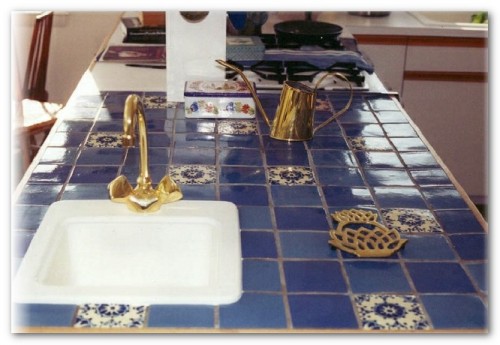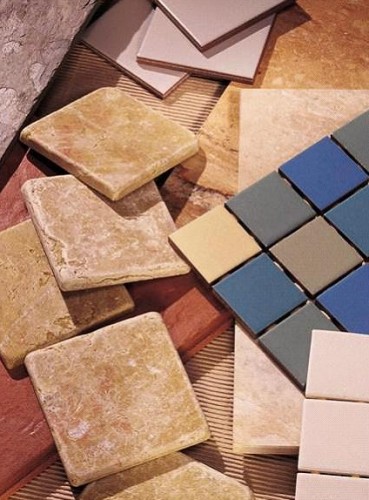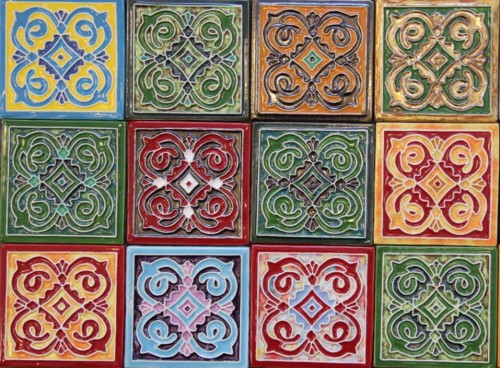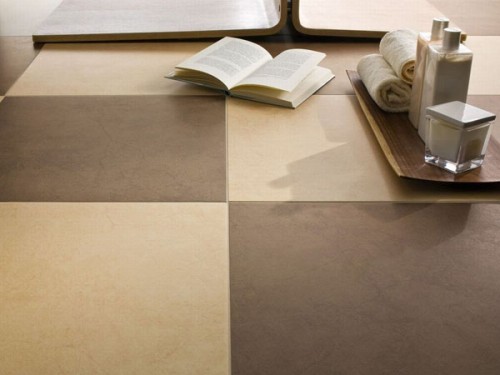It is difficult to say who for the first time guessed to finish the table with ceramic tiles, and this is not important. The main thing is that today anyone can afford to find beautiful and durable furniture, making a minimum of effort. Ceramic tiles capable of instant to give an old, shabby table a new life or decorate an unsightly interior item, giving it an original style.
Content
The pluses of the original solution
Today, the building materials market is characterized by a tremendous choice of ceramic tiles for every taste. Here you have a plain glossy classic, and stylish matte tiles, and intricate murals, in general, choose - I don’t want to. You can finish the oval table with ceramic tiles by adding original mosaic inserts, and then apply them on other interior items. For example, if your kitchen table is “painted” with roses or ornaments, you can let the same drawing along the outline of the cabinet or under the ceiling to create a harmonious interior in one spirit.
There are many options, and the fact that ceramic tiles allows you to create an unusual interior is clear without excess demagogy. But if the merits of this solution were limited only to decorative qualities, there would be no need to write an entire article on this topic.
Ceramic tiles, first of all, increase the operational characteristics of the finished surface, whether it is floor, walls or furniture. If you have an old, overwhelming, water and a lot of repairs, a dining table, with ceramic tiles on top of the scratched surface, it will look much more beautiful than covered with an oilcloth. Yes, and such furniture will last more than one year!
High -quality solid ceramics are not afraid of hot dishes, or scratches from a knife, nor accidentally spilled liquid. You can do anything with such a table, the main thing is not to forget to wipe the surface in time with a rag in order to enjoy the clean glue of the tiles again.
So, we list the main advantages of tables covered with ceramic tiles:
- high aesthetics;
- wear resistance;
- durability;
- simplicity in operation and care;
- hygiene.
How to choose tiles
To enjoy all the above advantages, it is necessary to choose the right ceramic tile. Not all manufacturers can boast of solid products that would not be painted due to accidentally spilled red wine and would not deteriorate because of the hot pots put on it. The requirements for ceramic tiles for the kitchen table are much higher than for walls.
First of all, pay attention to the thickness of the tile. It should be no thinner than 5 mm, otherwise such a coating can burst if you put a hot pot on the table or, say, you will make chopping ones. Since the thickness should exceed 5mm, wall tiles automatically disappears.
Pay attention to thin floor tiles. Such products have sufficient thickness as some types of mosaic tiles. As for the coating, most people prefer matte tiles, since glossy needs more careful care.
However, no matter how firmly the tiles you bought, you should not use it as a cutting board. If you cut it right on the table, the knife will quickly become dull, and it will be difficult to roll the dough on such a surface - the joints between the tiles will interfere. The last problem is solved simply - by installing a monolithic marble slab.
Useful advice: so that the cutting board does not slide along the smooth ceramic surface, glue a piece of rubber or a thin rubber leaf over the entire surface on its back.
Do not choose too large tiles with a side of more than 15 cm. In any case, they will have to be cut, and the table will not look very beautiful. If you are going to decorate the sliding table with ceramic tiles, the size of the gaps should be taken into account, which will decrease due to gluing tiles. It may be necessary to adjust the mechanism itself so that the countertop does not get stuck during assembly.
As for manufacturers, the market can offer a lot of options. Basically, foreign products prevail in specialized stores. One of the leading world manufacturers is Italy. A table with ceramic tiles from Italian masters is able to set the mood and style of the entire room. If you prefer something simpler and do not chase on pompous classics or fashion trends, you can safely buy domestic tiles. Recently, a trend in the use of tile battle has been increasingly observed to create an original mosaic on the floor, walls and furniture. Perhaps this option is more suitable for you, and much less money will be spent.
For those who are not inclined to spontaneous creativity, there is another manufacturer who has proven himself as a supplier of high -quality, durable and beautiful products - Malaysia. Tables with ceramic tiles in this case will last more than one year and will always delight with a brand new shiny coating.
Table finish
Materials
To finish the table with ceramic tiles, it is not enough to have only the coating and glue itself. It is necessary to prepare a number of materials.
Materials:
- ceramic tiles (tile itself, borders and corners);
- special glue for floor tiles;
- composition for grouting seams on an epoxy basis;
- reiki for the edging, the width of which is equal to the width of the thickness of the countertop + tiles;
- sealant;
- means to remove grout.
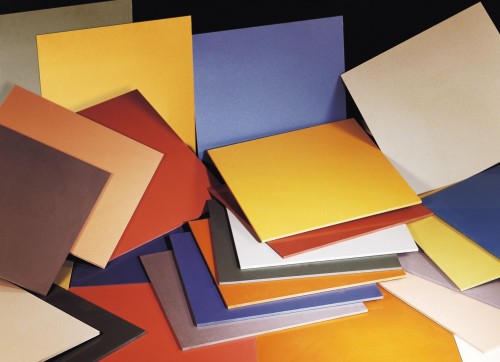
Tools
In the process of finishing work, you may need not only standard tools that can be found in any house, but also special devices. In order for the work to go smoothly and quickly, it is better to stock up on them in advance.
Tools:
- cutter for ceramic tiles;
- "Iron" (grind the edges of the tile);
- toothed spatula;
- gaskets 2 mm;
- plastic label for grouting;
- vetosh.

The course of work
If you are finishing the old kitchen table, first clean it and sand it. If you make a table from scratch, as the basis for the countertop, 12mm plywood panels with a thickness or chipboard 19 mm thick are suitable. It is best to calculate the dimensions in advance during the construction of the table so that they are multiple of the size of the tile. So you will be able to avoid ugly halves and a sharp occurrence.
The course of work:
- Clean the surface of the base (countertop) from dust and remove all the irregularities.
- Mark the countertop so that all the cut pieces of the plates are in its posterior part, non -none near the plate or sink, if you finish the built -in countertop.
- Whatever shape your kitchen table is, it is necessary to indicate one “key” tile, marking it on the surface so that it sets the direction of the location of other tiles. So you get an even row or a harmonious pattern. Circle this tile with a pencil around the perimeter and, focusing on it, make the marking of the entire countertop.
- The nature of the cladding directly depends on the design of your future countertop. So, if you are going to use curbs, then you need to start lining with them, having previously attached an auxiliary rail to the edge.
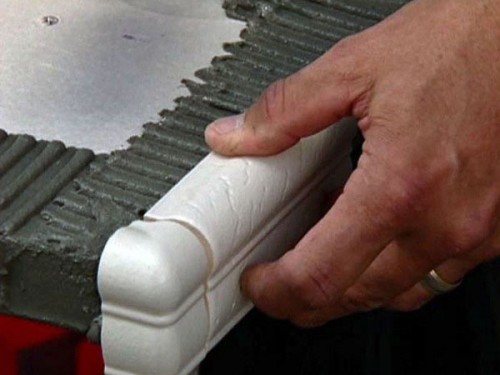
- Distribute spatula distribute the glue in space that will fit 4-5 plates. Do not coat the entire table at once, since the glue composition dries very quickly. The thickness of the glue layer should be no more than 3 mm, otherwise the excess will simply get out between the tiles and spoil the appearance.
- Do not forget to separate whole tiles from each other with gaskets. If rails go along the edge of the table, that between them and adjacent tiles it is also necessary to place gaskets.
- When you glue 4-5 tiles, check the level of horizontal, putting the cutting segment on top. If you notice a curvature, there is still time to tear the tile until the glue is frozen, and glue it correctly.
- When all the tiles took in their place, dilute the epoxy grout and process the seams between the elements. It does not cost a lot of grouting at once, since it dries quite quickly. Excess grouting after drying with a special composition and rags. Judging by numerous reviews, a table with ceramic tiles is best processed with epoxy grout, since it is incredibly durable, not afraid of moisture and does not emit toxic substances.
How to wrap the seams between the tiles correctly, you will learn from the video below

